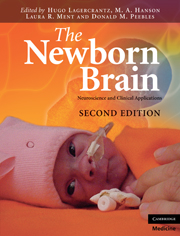Book contents
- Frontmatter
- Contents
- List of contributors
- Preface to the First Edition
- Preface to the Second Edition
- 1 Reflections on the origins of the human brain
- Section 1 Making of the brain
- Section 2 Sensory systems and behavior
- Section 3 Radiological and neurophysiological investigations
- Section 4 Clinical aspects
- 16 Infection, inflammation, and damage to fetal and perinatal brain
- 17 Hypoxic–ischemic encephalopathy
- 18 Clinical assessment and therapeutic interventions for hypoxic–ischemic encephalopathy in the full-term infant
- 19 Clinical aspects of brain injury in the preterm infant
- Section 5 Follow-up
- Section 6 Consciousness
- Index
- Plate section
- References
18 - Clinical assessment and therapeutic interventions for hypoxic–ischemic encephalopathy in the full-term infant
from Section 4 - Clinical aspects
Published online by Cambridge University Press: 01 March 2011
- Frontmatter
- Contents
- List of contributors
- Preface to the First Edition
- Preface to the Second Edition
- 1 Reflections on the origins of the human brain
- Section 1 Making of the brain
- Section 2 Sensory systems and behavior
- Section 3 Radiological and neurophysiological investigations
- Section 4 Clinical aspects
- 16 Infection, inflammation, and damage to fetal and perinatal brain
- 17 Hypoxic–ischemic encephalopathy
- 18 Clinical assessment and therapeutic interventions for hypoxic–ischemic encephalopathy in the full-term infant
- 19 Clinical aspects of brain injury in the preterm infant
- Section 5 Follow-up
- Section 6 Consciousness
- Index
- Plate section
- References
Summary
Definition and diagnostic criteria
The term hypoxic–ischemic encephalopathy (HIE) implies a clinically apparent acute disturbance in brain function resulting from a period of critical deprivation of cerebral oxygen delivery and/or blood supply. For the diagnosis of HIE to be upheld there needs to have been obstetric evidence of risk of hypoxia/ischemia to the fetus (e.g., reduced fetal movements, prolapse of the umbilical cord, late decelerations of the fetal heart, fresh meconium, placental abruption, etc.) after which the infant is born in poor condition, with delayed onset of respiration, and is then observed to have cerebral dysfunction (e.g., hypotonia, inability to suck, abnormal posture, clonic movements).
The finding of metabolic acidosis or raised lactate levels in cord blood or blood taken within 30 minutes of birth provides important supporting evidence that there has been acute hypoxia–ischemia at or shortly before delivery. Further support for a global hypoxic–ischemic episode is provided by deranged liver function (raised transaminases), a period of renal impairment with oliguria and raised serum creatinine, cardiac dysfunction, and disseminated intravascular coagulation. The diagnosis of HIE also requires that steps have been taken to rule out other causes of cerebral dysfunction such as infection, preexisting anatomical abnormalities of the brain, or an inherited metabolic disease.
As it is often difficult to be sure if hypoxia–ischemia is the cause of encephalopathy, some authors prefer the term neonatal encephalopathy, which makes no assumptions or exclusions as to etiology.
- Type
- Chapter
- Information
- The Newborn BrainNeuroscience and Clinical Applications, pp. 281 - 300Publisher: Cambridge University PressPrint publication year: 2010



